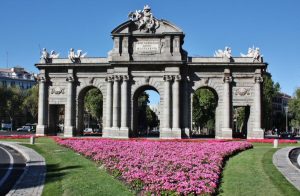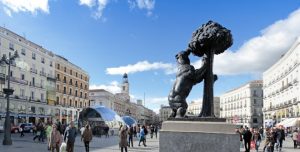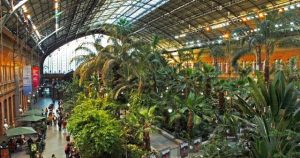Every classroom at Inhispania is named after a famous landmark or building in Madrid, so today we are taking you on a history tour of Madrid, through some of our classrooms at the school. I hope that you learn something new today which you didn’t previous know about this beautiful city, and you can follow along by watching our guided Youtube videos below.
1. Puerta de Alcalá
- Situated in the centre of the Plaza de la Independencia, the Puerta de Alcalá was one of the 5 ancient royal gates that provided access to the city, along with la Puerta de Toledo, la Puerta de Hierro, Puerta Real and Puerta de San Vincente.
- The arch, completed in 1778, was commissioned by Carlos III to replace another from the 16th.
- You might think that the king would have chosen a Spanish architect to design such an important monument, but the architect, Francesco Sabatini, was actually Italian.
- It was the first arch to be built in Europe after the fall of the Roman Empire and precursor to other well-known arches e.g. the Arch de Triumph in Paris or the Brandenburg Gate in Berlin.
- The origin of the arch´s name is simple – it was located on the route to Alcalá de Henares – however not everything about the monument is so easily explained. You might have noticed that the two sides of the arch are decorated differently, but have you ever wondered why?Some people say that Sabatini sent the king several designs, and that he was unable to choose between them. Others claim that the king accidentally approved both of them, and as the architect didn´t dare point out his mistake, he decided to combine the two!


2. Retiro
- Next to the Puerta de Alcalá is Retiro park, a green oasis in the centre of Madrid.
- The park began as property of the Spanish monarchy in the 18th century, and the following century it became a public park as we know today.
- It is 118 hectars in size and here we can find the:
- Palacio de Cristal: a Crystal Palace made almost entirely of glass, which only took 5 months to build and was completed in 1887. Originally designed as a greenhouse to display exotic plants, today it serves as an exhibition space
- Pabellón de los Jardines de Cecilio Rodríquez: a breath-taking garden, home to tens of brightly coloured peacocks. Its perfect box hedging, as well as ivy covered pergolas, makes it a beautiful spot for relaxing or taking a peaceful walk away for the runners and cyclists in the rest of the park.
- A large lake where you can hire a boat and row around in the peaceful, bright blue water.


3. Puerta de Sol
- It’s one of the most important and political squares in Madrid.
- Its semi-circular layout is the hub of several of the city’s busiest and most historical streets, and it is home to some of its most representative elements:
- The Bear and the Strawberry Tree: the symbol of the city (and the logo of Atletico madrid)
- The Kilometer 0 plaque: which marks the starting point of where all roads in Spain meet
- The statue of Charles III: the king who modernized the city.
- Also every New Year’s Eve, hundreds of Spaniards gather under the famous clock of the Casa de Correos (the old Post Office building) and eat 12 grapes, one for every chime of the bell before the arrival of the New Year.


4. Plaza Mayor
- One of the most visited squares in Madrid, located in the heart of Madrid’s historical centre, this square is characterised by symmetry and austerity, with 9 entrance arches, and picturesque buildings surrounding it
- It was constructed in 1619, but was initially called Plaza del Arraba. Later it adopted other names, such as Plaza de la Constitución, Plaza Real and Plaza de la República. Its current name has been preserved since the end of the Civil War (1936-1939)
- The square is crowned by the equestrian statue of Phillip III, constructed in 1616, a gift given to the Spanish king by the Duke of Florence
- Additionally, the most important building and the first to begin construction in 1590 was the Casa de la Panaderia, the most important bakery in Madrid at the time
- The Plaza Mayor has a more dramatic history than you might expect, having survived three big fires. The first, in 1631, engulfed the Casa de la Carnicería, lasting three days, destroying over fifty buildings, and causing three deaths.
- In 1672, a lantern caught fire in the portico of the Casa de la Panadería, leaving only the cellar and the ground floor standing. The restoration of the building took sixteen months, and today you can see a plaque in the building which commemorates this event.
- The third and most destructive of the fires took place in 1790. It began in the Portal de Paños, and destroyed a third of the square´s perimeter. The fire lasted nine days, and as there was not enough water in the surrounding wells, the only way to put it out was to pull down surrounding buildings to block the progress of the flames!
- In the past, the Plaza Mayor was used for a wide range of activities. Initially it was used for religious judgments and public executions, but nowadays, it’s used for more light-hearted events such as markets and festivals.


5. Paseo del Prado
- This is one of the main boulevards in Madrid, densely lined with hundred-year-old trees, which runs north-south between the Plaza del Emperador Carlos V and the Plaza de Cibeles, with the Plaza de Cánovas del Castillo (the location of the Fuente de Neptuno).
- This avenue is the landmark for city residents and the location of important cultural and tourist spots, including the so-called “Golden Triangle of Art,” which encompasses 3 museums: the Prado Museum, Reina Sofía, the Thyssen Museum.


6. Atocha
- Atocha, located in the Plaza del Emperador Carlos V, is the largest the railway station in Madrid, connecting almost all of the cities in the country, and has the highest number of daily passengers passing through in the whole of Spain.
- Initially a dock in 1851, the architect Alberto de Palacio y Elissague collaborated with Gustave Eiffel to create the wrought iron, Renewal-style station we know today
- The station however, has been renovated on several occasions; in 1888, the building was partially destroyed by a fire and between 1985 and 1992, the station was enlarged 4 times its original size.
- After its renewal, the station was divided into three: Madrid-Puerta de Atocha, Madrid-Atocha Cercanías and Atocha Renfe
- Inside the station itself, is a 4,000m2 tropical garden, containing 7000 plants and has over 500 different species of animals and plants. Although the most popular inhabitants of the garden are the baby turtles.


If you would like to watch a tour of our classrooms and find out more history about the city, click below:



